Outsmart your local competitors
Perform local competitor analysis using our free tool, get insights on the best-performing local businesses in your area. Analyse their strengths across key platforms and industries.
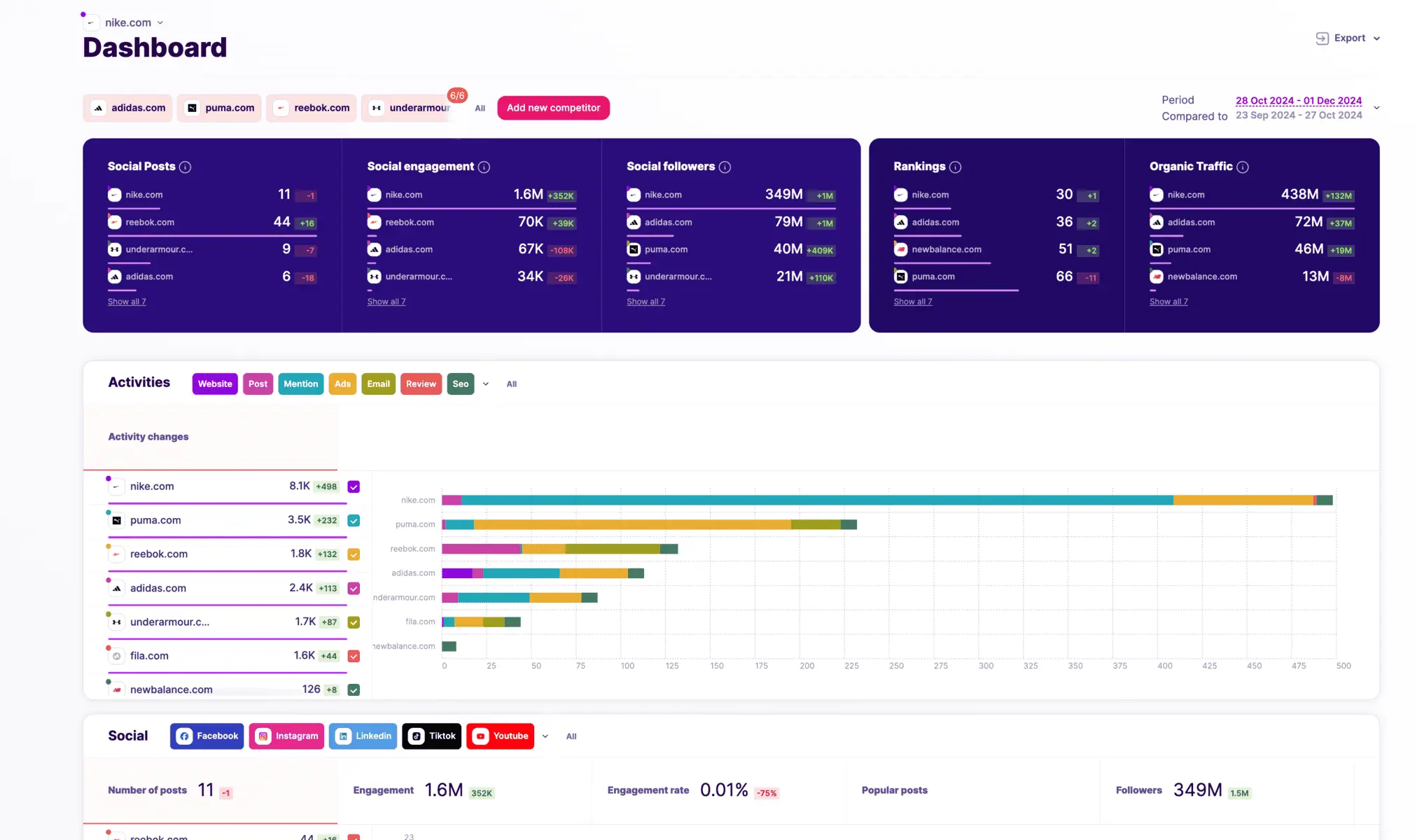
Table of Contents
Let’s face it: Running a small business is like competing in a hyper-local talent show. Everyone’s got a act—yours just needs to shine brighter. A local competitor analysis isn’t about being nosy (okay, maybe a little). It’s about learning the rules of the game so you can win.
What is a Local Competitor Analysis?
Think of it like spying on your neighbor’s BBQ to see why their burgers always draw a crowd. For small businesses, it means:
Identifying rivals: Who’s selling the same stuff within 5 miles of your shop?
Studying their moves: What’s their secret sauce? Cheap prices? Killer social media? Free puppy cuddles with every purchase?
Spotting gaps: Maybe their customer service stinks, or their website looks like it’s stuck in 2005.
Real-World Example:
Imagine you run a coffee shop. Your competitor down the street has a loyal following for their $1 refills. But they close at 3 PM. Boom—stay open till 7 PM and corner the after-work crowd.
Why Bother? (Besides Avoiding Bankruptcy)
Ditch the Guesswork:
Stop wondering, “Why is no one buying my artisanal pickles?” and start knowing.
Data > gut feelings. Always.
Steal Their Good Ideas (Ethically, Ofc):
If the bakery next door kills it with “Free Cookie Fridays,” try “Free Coffee Mondays.”
Pro tip: Add a twist so you’re not a copycat.
Fix Your Weak Spots:
Maybe your landscaping biz loses clients because you don’t offer weekend hours. Time to adjust.
Price Like a Pro:
If your rival charges 50/hourforplumbing,butyou’refasterandfriendlier?Charge50/hourforplumbing,butyou’refasterandfriendlier?Charge55.
How to Start (Without Feeling Like a Creepy Stalker)
Make a Hit List:
Google “[Your Service] + [Your City]” (e.g., “dog groomers Austin”). The top 5 results? Those are your VIP rivals.Play Mystery Shopper:
Call their store. How do they treat customers?
Visit their website. Is it smoother than yours?
Social Media Snooping:
Check their Instagram. Do they post daily? Run giveaways? Respond to comments?
Ask Your Customers:
“Have you tried [Competitor]? What did you love/hate?” (Bonus: Offer a discount for honest feedback.)
What are the Benefits of Analyzing Your Local Competitors?
Understanding your local competitors isn’t just about keeping up—it’s about outsmarting them. Here’s how this analysis fuels growth:


1. Decode Market Dynamics & Customer Preferences
What it reveals: Which products/services locals actually want vs. what competitors are pushing.
Example: A bakery discovers via competitor reviews that gluten-free options are in demand but poorly stocked nearby.
Action: Use Google My Business (GMB) Q&A sections and local Facebook groups to mine unmet needs.
2. Uncover Gaps to Dominate
Common gaps:
- Poor service hours (e.g., closed Sundays when demand spikes)
- Limited delivery radius (e.g., stops at 5 miles in a 10-mile service area)
Tool hack: SpyFu’s “Kombat” report shows competitors’ underperforming keywords—steal them.
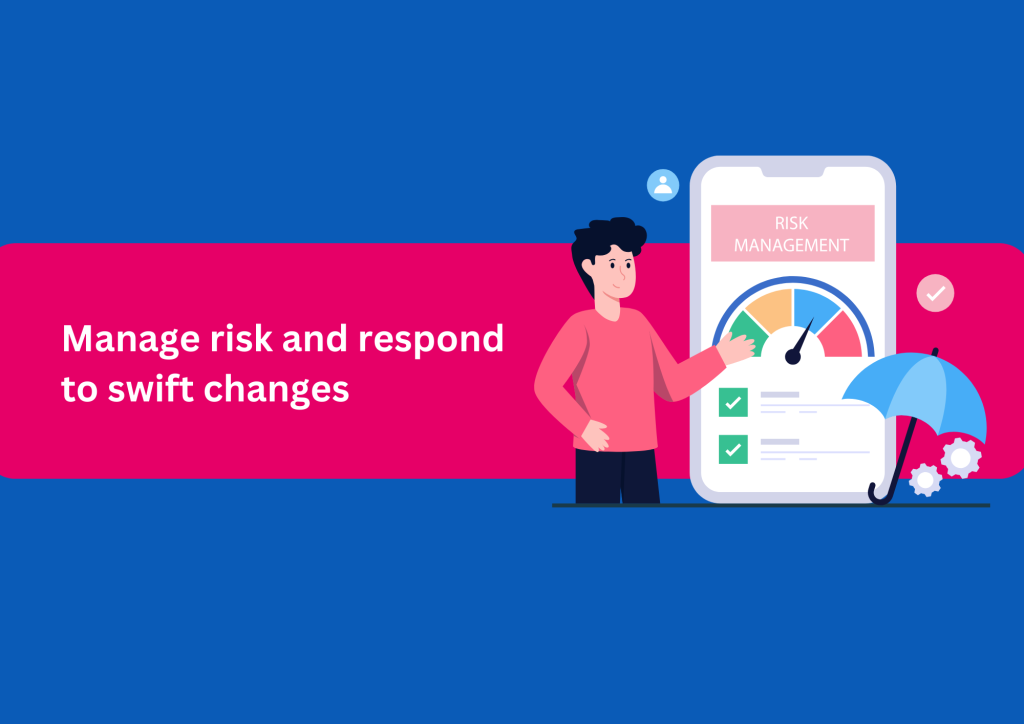

3. Sharpen Risk Management
Early warning signs:
- Competitors slashing prices (check their GMB posts for promotions)
- Sudden review surges (indicating aggressive marketing)
Defense tactic: Set Google Alerts for competitors’ names + “new location” or “sale.”
4. Spark Innovation Through Reverse-Engineering
Steal-worthy strategies:
- A rival’s loyalty program driving 5-star reviews
- Their “15-minute pickup” guarantee you lack
Innovation playbook: Run SWOT analyses quarterly to turn their weaknesses into your differentiators.
How to Find Your Local Competitors
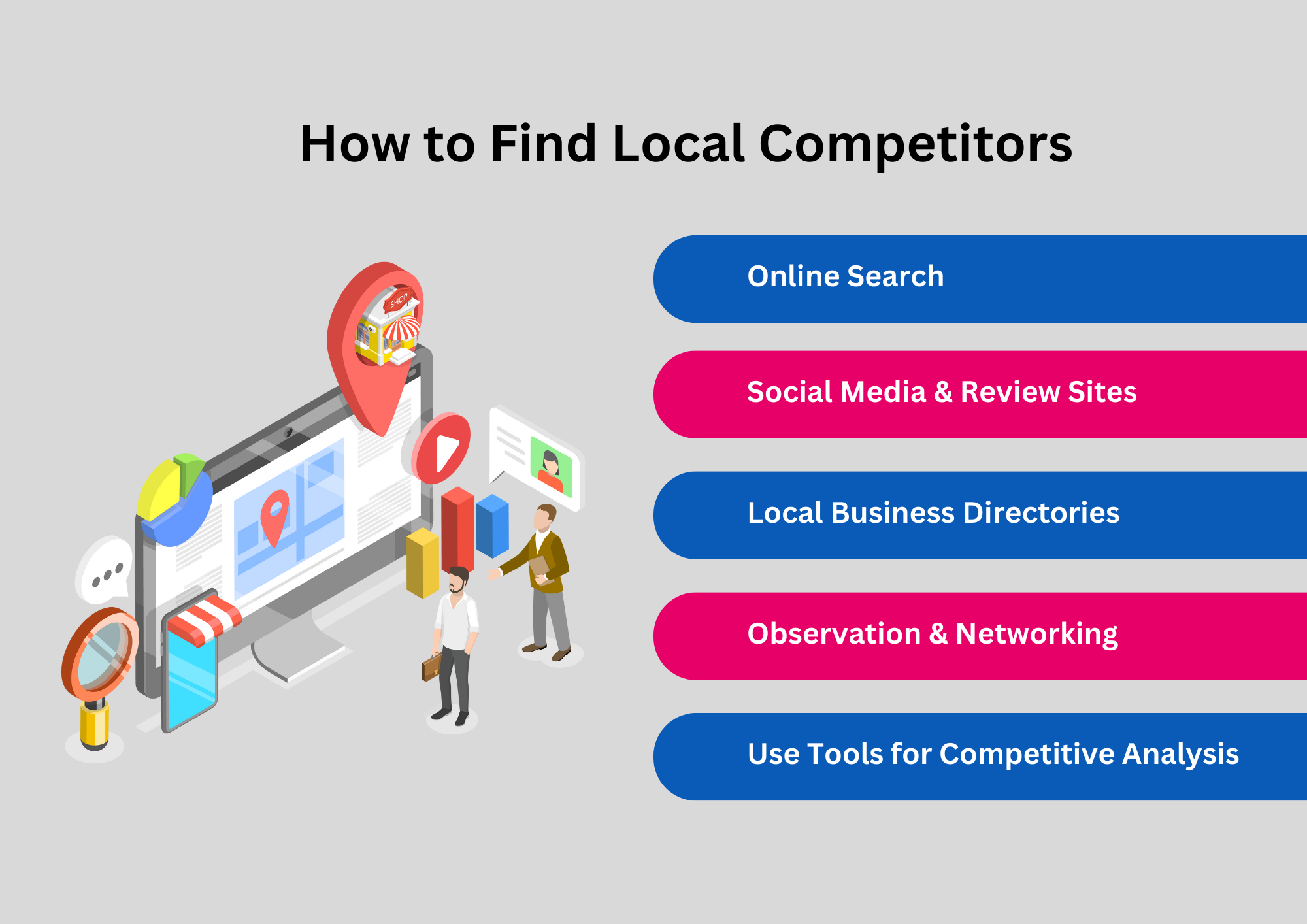
Identifying local competitors isn’t just about making a list—it’s about uncovering threats and spotting weaknesses to dominate your market. Here’s how to do it systematically:
1. Guerrilla Google Searches
Keyword hacks:
- Search “[Your Service] near me” + [Your City] (e.g., “dog grooming Austin”)
- Check Google Maps for the 3-pack businesses dominating local results
Pro Tip: Use search operators like
site:yelp.com "best tacos" [Your City]to find rivals on third-party platforms.Real Impact: A coffee shop found 4 competitors by searching “organic cold brew [City]”—then undercut their prices by 15%.
2. Social Media & Review Recon
Platform tactics:
- Yelp: Filter by “Most Reviewed” to find established players
- Instagram Geotags: Search location-specific hashtags (e.g.,
#AustinVeganEats) - Google Reviews: Study 1-3 star reviews of competitors to find service gaps
Tool: Use Mention to track brand mentions of local businesses.
Example: A salon discovered a rival’s frequent “long wait time” complaints and launched instant booking.
3. Local Directory Deep Dives
Key sources:
- Chamber of Commerce member lists
- Industry-specific hubs (e.g., Houzz for contractors)
- Nextdoor.com for hyperlocal chatter
Pro Move: Export BBB complaints to find competitors with unresolved issues.
4. On-the-Ground Espionage
Secret Shopping:
- Time response rates to calls/emails (e.g., “Do you offer weekend appointments?”)
- Photograph competitor pricing boards or promotional flyers
Event Infiltration: Attend trade shows to:
- Collect marketing materials
- Note loyalty programs (e.g., “10th coffee free” cards)
Case Study: A gym owner joined a rival’s free trial to replicate their onboarding flow but added 24/7 access.
5. Competitor Analysis Tools
Free Tier:
- Google My Business – Compare your “Popular Times” vs. competitors’
- SEMrush Local SEO Tool – Track rivals’ ranking keywords
AI-Powered Option: Use Competitors App’s Free Competitor Finder to automate detection.
How to Conduct a Local Competition Analysis
You’ve got your list of local competitors—now it’s time to dig into their playbook. Here’s how to break down their strategies without overcomplicating things:

Evaluate Their Online Presence
Start with a deep dive into their digital footprint. Pull up their website on your phone—does it take forever to load? That’s your first win. Check their Google My Business page: Are the photos from 2018? Do they respond to reviews, or leave angry customers hanging?
Social media snooping:
Instagram: Do they post once a month or spam 10 stories daily?
Facebook: Look for events they’re hosting—like “Free Taco Tuesdays” you didn’t know about.
Real example: A pizza shop owner noticed his rival’s website didn’t list gluten-free crusts. He added it to his menu and plastered “GLUTEN-FREE? WE GOT YOU” on his storefront. Sales jumped 20%.
Analyze Their Product or Service Offerings
Make a quick cheat sheet comparing your stuff to theirs. For example:
Service | You | Competitor |
|---|---|---|
Oil Change | $49.99 (free car wash) | $55 (no extras) |
Tire Rotation | Free with annual plan | $20 per visit |
Gap alert: If they charge $100 for house calls and you don’t offer them—boom, new revenue stream.


Check Their Pricing Strategy
Call them. Seriously. Ask:
“What’s your rate for [service]?”
“Do you offer senior discounts?”
“Is there a fee for cancellations?”
Price tracking hack: Sign up for their email list. When they blast a “20% Off Summer Sale” promo, beat it with 25% off.
Observe Their Marketing Tactics
Where are they advertising?
Google Ads: Search “[your service] + [your town]” and see if their ads pop up.
Local radio: Listen during drive time—are they running cheesy jingles?
Yard signs: Spot their branding at intersections or community boards.
Free tool: Facebook Ad Library lets you spy on their active campaigns.


Understand Their Customer Experience
Go undercover:
Visit their store: Time how long it takes to get helped.
Buy something cheap: How’s the checkout process?
Email a question: “How late are you open?” See if they reply.
Note: If their staff rolls their eyes at basic questions, train your team to be painfully polite.
Gather Insights from Customers
Review mining:
Filter Google reviews by “newest”—look for rants about slow service or price hikes.
Check niche sites: HVAC companies? HVAC-Talk forums. Restaurants? Local foodie Facebook groups.
Simple survey: Ask customers at checkout:
“What’s one thing you wish [Competitor] did better?”
“Would you switch to us if we offered [X]?”


Review Their SEO Strategy
Free tricks:
Google “[competitor name] + [your town]” to see their meta descriptions.
Use AnswerThePublic to find questions they’re answering (like “best burger near me”).
Local SEO quick fix: If their Google My Business profile has typos or old hours, make sure yours is flawless.
The Best Tools for Conducting a Local Competitor Analysis
To effectively analyze your local competitors, leveraging the right competitor analysis tools can make the process more efficient and provide deeper insights. Here’s a list of some of the best tools available for conducting a comprehensive local competitor analysis:

Competitors.app
A key tool for those looking to automate their competitor analysis process. Competitors.app monitors your competitors' online activities, including website updates, social media changes, and email marketing strategies. It provides real-time alerts and insights, making it easier to keep track of your competitors' moves and strategize accordingly. For local businesses Competitors App has a really unique feature that allows you to monitor insights in your local area even in a zip code level.

Google My Business (GMB) Insights
Use GMB to see how your business performs in local searches compared to your competitors. It provides valuable data on search visibility, customer actions, and how customers find your listing.

SEMrush
This tool is excellent for analyzing competitors' SEO strategies, keyword rankings, and online advertising. SEMrush's features allow you to understand your competitors' online presence and discover gaps in your own strategy.
Key Metrics to Measure when Analyzing Local Competitors
1. Market Share
“Are they feeding the whole town, or just scraping crumbs?”
How to eyeball it:
Count cars in their parking lot at lunch rush vs. yours
Compare Google My Business review counts (e.g., 150 vs. your 50 = they’re dominant)
Example: A food truck owner tracked rivals’ daily Instagram check-ins to estimate crowd size.
2. Customer Satisfaction
Don’t just read stars—hunt for pain points:
Repeated complaints: “Takes 20 minutes to get a coffee” → Open a faster express lane
Response style: Do they argue with bad Yelp reviews? Stay classy in your replies to look better.
Real move: A salon saw rivals got slammed for “judgy stylists.” They trained staff to say, “Love your vibe—how bold do you wanna go?”
3. Website Traffic
Free tricks:
Use Google’s “PageSpeed Insights” to see if their site loads slower than yours (if yes, brag about your speed)
Check Wayback Machine for outdated promotions still on their site
Example: A roofer noticed competitors’ sites lacked before/after galleries—added his own and ranked higher.
4. Social Media Engagement
Steal their best posts:
If their “$5 Taco Tuesday” Reel gets 1K likes, post “$4.75 Taco Thursday”
Note their quiet periods (e.g., no posts on Sundays) → Flood feeds when they’re offline
Hack: Use Instagram’s “Following” tab to stalk their likes without logging in.
5. Conversion Rates
Dirty little secrets:
Sign up for their email list to see how often they beg for sales (“LAST CHANCE!”)
Test their checkout flow: If it takes 4 steps to book, make yours 2
Case study: A gym found rivals’ website had no “Book Free Trial” button—added one and tripled signups.
6. Product or Service Pricing
Play dumb customer:
Call and ask, “What’s the catch with your $99 special?”
Check their website’s fine print for hidden fees (e.g., “+$20 disposal charge”)
Real story: A tire shop undercut rivals by $10 per tire but charged $15 for install—made more profit.
7. Brand Perception
Listen where they’re not:
Facebook groups like “[Your Town] Rants & Raves” spill unfiltered tea
Watch for local news mentions (e.g., “Local Cafe Donates to Food Bank”) → Copy their goodwill moves
Example: A vet clinic started posting “Rescue Pet Fridays” after seeing rivals ignore community work.
8. Content Quality and Strategy
Be the upgrade:
If their YouTube tutorials have 480p quality, shoot yours in 4K
Rewrite their boring blog titles: “5 Plumbing Tips” → “How to Avoid a $10K Water Bill”
Tool: Use Canva to make their PDF menus look ancient compared to yours.
9. SEO Rankings
Local keywords to poach:
“[Service] near [Landmark]” (e.g., “car wash near Costco”)
“Open late [Day]” if they close early
Free trick: Google “[Competitor Name] + reviews” to see their weak spots.
10. Innovation and Product Development
Be the copycat with a twist:
If a rival adds “eco-friendly dry cleaning,” launch “eco-friendly + 1-hour pickup”
Monitor their “New!” banners in-store during recon missions
Example: When a burger joint added vegan patties, a competitor offered vegan and gluten-free buns—stole the spotlight.
How to Analyze Local SEO Competition

(Or: How I Discovered My Coffee Shop Rival Was Secretly Winning With Cat Photos)
Let’s get this straight: Comparing Google Business Profiles (GBP) isn’t corporate espionage—it’s survival. Last year, my friend’s bakery lost 30% of their “birthday cakes near me” traffic to a competitor whose GBP showed a baker high-fiving a golden retriever. True story. Here’s how to spy like a pro:
Examine Profile Completeness
Google rewards businesses that treat their GBP like a dating profile. That vegan café down the street? Their profile lists:
Gluten-free pancake Tuesdays
Exact opening hours for Thanksgiving Eve
12 service categories (including “vegan dessert whisperer”)
Your move: If your GBP has more blank spaces than a teenager’s resume, you’re basically ghosting Google.
Analyze Use of Keywords
Your competitor’s description probably reads: “Family-owned since 1982 | Best [keyword] in [City] | Free cookie with every oil change.” Meanwhile, yours says: “We sell stuff.”
Pro tip: Use AnswerThePublic to find phrases real humans search—like “plumber who won’t judge my hairball clog” vs. “plumbing services.”
Review the Quality and Quantity of Photos
The pizza place ranking #1 here has 47 photos:
12 of pepperoni closeups
1 of their fire extinguisher (???)**
34 of customers doing TikTok dances
Lesson: More visuals = more “I wanna go there” vibes. Bonus if you include something bizarre enough to get screenshotted.
Evaluate the Frequency and Quality of Posts
Top competitors post on GBP like it’s Instagram:
“Taco Tuesday BOGO—bring your pet iguana for free guac!”
Monthly “Meet our barista” stories
Behind-the-scenes reels of their dumpster being emptied (hey, it’s “authentic”)
Warning: Posting once a year? Google thinks you’ve gone out of business.
Check for Q&A and How They’re Handled
The real MVP move? My dentist answers questions like:
Q: “Do you accept scared adults who cry?”
A: “Yes, and we give out Pokémon stickers post-cleaning. Gotta catch ‘em all!”
Steal this: Turn FAQs into personality showcases.
Assess Reviews and Responses
That hardware store with 500 reviews? Their secret: replying to EVERY review with dad jokes.
1-star: “Your hoses are overpriced!”
Reply: “Our hoses are like fine wine—overpriced but worth it. Next round’s on us!”
Fact: Businesses responding to 25%+ reviews get 35% more clicks (Local SEO Guide, 2023).
Observe Attributes and Features Used
The car wash using “Rainbow Soap Dances” as an attribute gets 2x more “fun car wash” searches. Meanwhile, yours says “parking available.”
Wake-up call: Attributes are cheat codes. “Free dog treats” > “Pet friendly.”
Look at Local SEO Performance
Ran a Moz Local report for a client and found:
Their competitor had 87 citations mentioning “emergency cupcake delivery”
Their own NAP (Name, Address, Phone) was listed as “Dave’s ?? Bakery 😎” on 4 sites
Tool hack: Use BrightLocal to find where your competitors are listed (yelp, niche blogs, that one angry Reddit thread).
Identify Unique Selling Propositions (USPs)
The barber shop down the street advertises: “We play 90s sitcoms loud enough to drown out your existential dread.” Meanwhile, your USP is: “Open Mondays.”
Brutal truth: If your GBP doesn’t scream “THIS IS WHY WE’RE DIFFERENT,” you’re wallpaper.
Monitor for Offers and Promotions
Top competitor’s GBP currently has:
“Free coffee if you beat our manager at Mario Kart”
“Bring a rival’s coupon for 20% off (we’re petty like that)”
Data point: Limited-time offers boost profile views by 50% (SEMrush, 2024).
Comparing Google Business Profiles

Comparing Google Business Profiles (GBP) of your local competitors is an effective way to understand how your business stacks up in terms of local search visibility and customer engagement. Here’s how you can conduct a comprehensive comparison:
- Examine Profile Completeness: Check if your competitors’ GBPs are fully completed with detailed business information. This includes business hours, contact information, categories, services, and products. A complete profile tends to rank better in local search results.
- Analyze Use of Keywords: See how well your competitors incorporate relevant keywords into their business description and posts. Proper use of keywords can improve a profile’s visibility for specific local searches.
- Review the Quality and Quantity of Photos: Profiles with more high-quality, relevant photos generally provide a better user experience and can attract more attention. Compare the number of photos, their quality, and how often they are updated.
- Evaluate the Frequency and Quality of Posts: Regular posts on GBP can improve engagement and keep the business top-of-mind with potential customers. Look at how frequently your competitors post and the type of content they share.
- Check for Q&A and How They’re Handled: The Questions & Answers section is a direct line of communication with potential customers. Review how your competitors manage this section, including response time and the helpfulness of their answers.
- Assess Reviews and Responses: Reviews significantly affect a business’s reputation and search ranking. Compare the number of reviews, overall ratings, and how actively and professionally your competitors respond to both positive and negative reviews.
- Observe Attributes and Features Used: Google Business Profiles offer various attributes to highlight specific features of a business, like “Free Wi-Fi,” “Outdoor Seating,” etc. See which attributes your competitors are using to attract different customer segments.
- Look at Local SEO Performance: Use tools like Moz Local to check how well your competitors’ profiles are optimized for local SEO. This includes consistency of NAP (Name, Address, Phone Number) across the web, local keyword optimization, and backlink quality.
- Identify Unique Selling Propositions (USPs): Through their GBP, identify any unique offerings or messages that make your competitors stand out. Understanding their USPs can help you refine your own value proposition.
- Monitor for Offers and Promotions: Some businesses use their GBP to promote special offers or events. Keeping an eye on these can provide insights into their marketing strategies and promotional tactics.
By conducting this detailed comparison, you can identify areas where your Google Business Profile may need improvement to enhance your local search visibility and customer engagement. It also helps in spotting opportunities to differentiate your business from local competitors, ensuring you attract more attention from potential customers in your area.
Analyzing Your Local Competitors’ Google Ads

Let’s get real: If your competitor’s Google Ads look like they were written by a ChatGPT knockoff, you’re already winning. But here’s how to dig deeper than a raccoon in a dumpster—using actual guerilla tactics I’ve tested:
Observe Ad Copy
Your competitor’s ad: “Premium Solutions for Optimal Outcomes.”
Their actual customers search: “plumber who won’t judge my hairball-clogged shower drain.”
What to steal:
– Ads that sound like a human wrote them (shocking, right?)
– CTAs like “Click here if you’re sick of overpriced [thing]” instead of “Learn More”
– True story: A bakery client outranked a chain by adding “Yes, we burn cookies sometimes—50% off our ‘oops’ batch!”
Analyze Keywords & Ad Groups
Tools lie. Real-world sleuthing wins:
Google “[Your Service] + [City] + sucks”
Find your competitor bidding on “alternatives to [Your Business Name]” (it’s war)
Discover they’re ranking for “free [thing] loophole 2024”
Nuclear option: Hijack their long-tail desperation keywords (“emergency [service] after midnight”).
Check Out Landing Pages
If their landing page has:
✓ Autoplay music
✓ A pop-up before you can scroll
✓ Stock photos of “happy customers” who look like hostage victims
You’ve already won. But if their page includes:
– A video of their mechanic singing Taylor Swift while fixing transmissions
– A “Why we suck less” comparison chart
– A hidden page titled “[Competitor Name]’s Clients Get 25% Off”
Copy them.
Evaluate Ad Extensions
The car dealership down the road uses:
– Sitelinks: “See our Yelp 1-star reviews (we earned ’em!)”
– Callouts: “Free coffee, no test drive required”
– Structured snippets: “Types of meltdowns we’ve seen in our lobby”
Your move: If your extensions sound like a robot wrote them, throw in a “P.S. Our receptionist hates the hold music too.”
Review Offers & Promotions
Track their promos like a soap opera:
Episode 1: “Free tire rotation with oil change!”
Episode 5: “Free oil change if you bring a rival’s coupon!”
Season finale: “We’ll Venmo you $10 to stop calling [Your Business].”
When they get desperate, double down on your USP.
Gauge Audience Targeting
Their ads feature:
☑️ TikTok dances → Gen Z bait
☑️ Grumpy cat memes → Millennial meltdowns
☑️ “Ask for Barbara” → Boomer bait
Drop subtle traps: Run a “Mention this ad for free [thing]” campaign. If Karens start pouring in, you’ve hit their demo.
Use Google’s Ad Preview Tool
What you’ll find:
– Your competitor’s ad shows up for “cheap [service] no questions asked”
– Yours appears for “luxury [service] for people who hate coupons”
Translation: They’re cornering the “I’m broke and desperate” market.
Track Changes & Trends
Signs they’re unraveling:
– Running “FREE ___” promos 3 months straight
– Ads suddenly target “[Your City] + divorce lawyers”
– Using AI-generated images of “customers” with 6 fingers
Strike when their CTR drops below their dignity.
Monitoring Your Local Competitors with Competitors.app

Monitoring your local competitors is a vital strategy for any business looking to maintain or enhance its position in the market. Competitors.app emerges as a pivotal tool in this endeavor, providing a comprehensive and automated solution to keep a close watch on your competitors’ activities. Here’s how Competitors.app enables you to effectively monitor your local competitors and adapt to market changes swiftly:
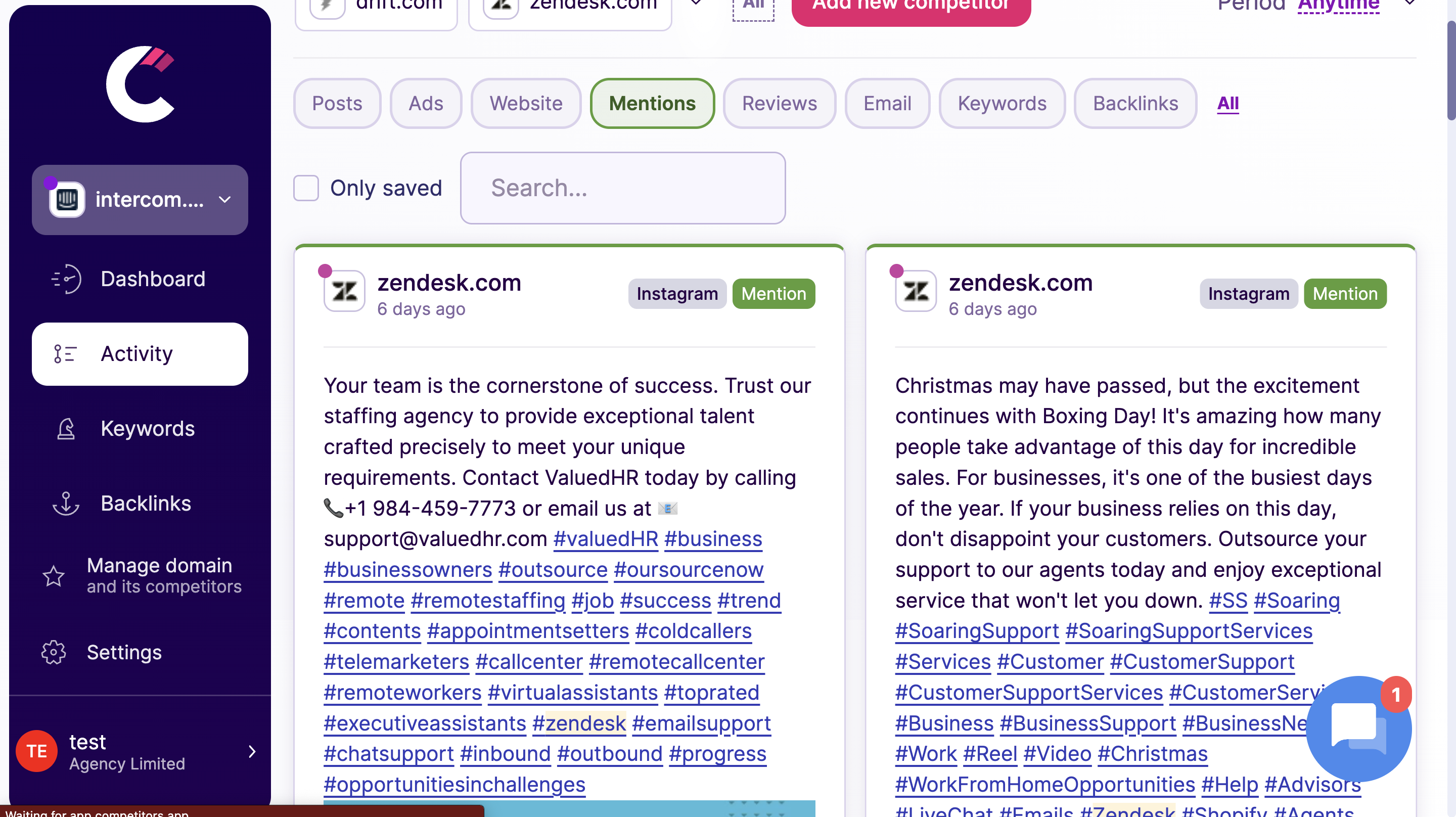


Automated Alerts for Online Mentions:
Competitors.app uses advanced technology to scan the web for any mentions of your competitors. Whether it’s news articles, blog posts, or significant updates, you’ll receive real-time alerts, ensuring you’re always informed about your competitors’ public engagements and media presence.
Social Media Tracking:
The platform offers robust monitoring capabilities across various social media channels. It tracks changes in posting frequency, content themes, engagement tactics, and promotional campaigns of your competitors. This feature allows you to gauge their social media strategy and audience engagement levels, providing insights into what works and what doesn’t in your shared market.
Comprehensive SEO and Website Analysis:
With Competitors.app, you get detailed insights into your competitors’ SEO strategies and website updates. The tool analyzes changes in SEO practices, content updates, and overall website performance, helping you understand your competitors’ online strategies and identify areas for improvement in your own SEO and content approach.



Direct Observation of Websites and Blogs:
Competitors.app makes it easy to keep an eye on any changes to your competitors’ websites and blogs. This direct observation can reveal shifts in their marketing messages, target markets, or strategic focus, allowing you to adapt your strategies accordingly.
Advertisement Monitoring:
It tracks and analyzes your competitors’ online and possibly offline advertisements, providing insights into their marketing strategies, target audiences, and promotional tactics. This knowledge helps you refine your advertising efforts to ensure they are more impactful.
Engagement in Industry Forums and Online Communities:
While Competitors.app automates much of the monitoring process, the insights it provides can guide more targeted engagement in industry forums and online communities. This strategic involvement can offer additional insights into competitors’ strategies and customer service approaches.
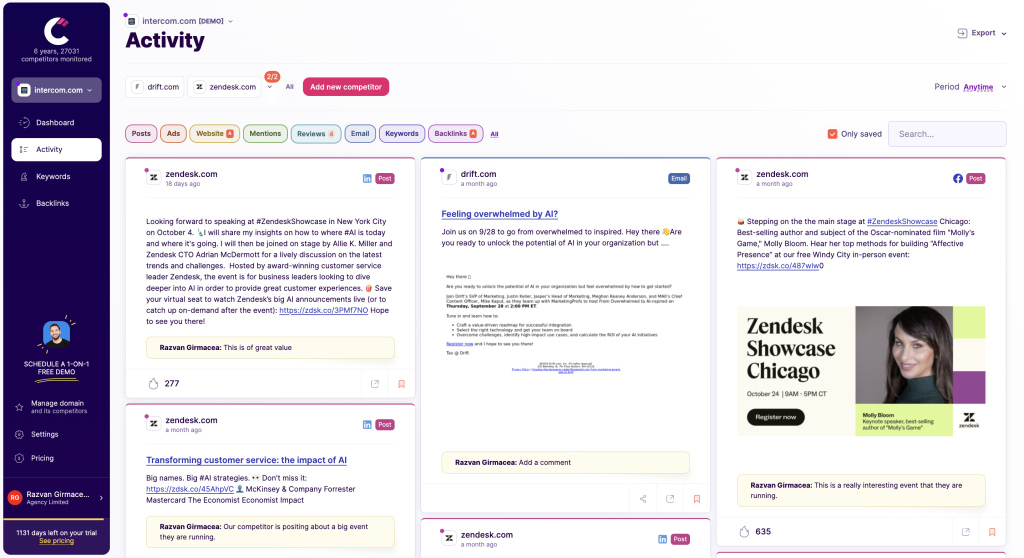
Analysis of Sales and Promotional Tactics:
By alerting you to your competitors’ sales, discounts, and special promotions, Competitors.app helps you understand their pricing and sales strategies. This information is crucial for developing competitive offers and promotions that attract and retain customers.
How can you evaluate the impact of which strategies are working for your competitors
Evaluating and noticing the impact of strategies that work for your competitors involves a combination of direct observation, data analysis, and market feedback. Here’s how you can systematically assess the effectiveness of your competitors’ strategies:
1. Monitor Performance Metrics
- Website Traffic and SEO Rankings: Use tools for analytics (if you have access to comparative data) to monitor changes in your competitors’ website traffic and SEO rankings. Significant improvements may indicate effective SEO or content marketing strategies.
- Social Media Engagement: Track changes in engagement rates, follower growth, and content virality on your competitors’ social media profiles. Tools like BuzzSumo or Hootsuite can provide insights into which types of content and which posting strategies are most effective for them.
2. Analyze Customer Feedback and Reviews
- Online Reviews and Ratings: Regularly check platforms like Google My Business, Yelp, and TripAdvisor to see customer reviews and ratings. Positive trends in reviews or frequent mentions of specific aspects of their service or product can indicate areas where they are succeeding.
- Social Media Sentiment: Use social listening tools to gauge the sentiment of mentions and discussions about your competitors online. This can help you understand public perception and the impact of their PR or customer service strategies.
3. Observe Sales and Market Share Changes
- Sales Volume and Revenue: While it might be challenging to get exact figures, any publicly available information on sales, revenue growth, or market share can provide clues about the success of their strategies.
- Promotional Campaigns Effectiveness: Monitor the frequency, creativity, and reception of promotional campaigns. High engagement levels, social media buzz, or increased market activity during these campaigns can signal their effectiveness.
4. Assess Content and Advertising Success
- Content Engagement: Look at the engagement metrics on their content, such as likes, shares, comments, and views. High-performing content could indicate successful content marketing strategies.
- Ad Performance: If you can access any data on their advertising campaigns (through ad intelligence tools or public case studies), analyze their reach, click-through rates (CTR), and conversion rates to evaluate the effectiveness of their advertising strategies.
5. Competitive Benchmarking
- Benchmarking Against Industry Standards: Compare your competitors’ performance against industry averages or benchmarks. This can help you identify which areas they are excelling in.
- Direct Comparisons: Compare similar campaigns or initiatives between your business and your competitors. For example, if you both launched similar products or services around the same time, comparing the market reception can offer insights into what strategies worked better.
6. Use Competitor Analysis Tools
- Competitors.app and Similar Platforms: Tools like Competitors.app automate the process of tracking your competitors’ online activities, including social media, website updates, and more. These tools can alert you to successful strategies by highlighting significant changes or trends in your competitors’ digital marketing efforts.
7. Customer Surveys and Market Research
- Direct Customer Feedback: Conduct surveys or focus groups with your customers or your target market to gather feedback on why they might prefer a competitor’s product or service. This direct feedback can provide valuable insights into the effectiveness of their strategies.
By combining these approaches, you can gain a comprehensive understanding of which strategies are working for your competitors. This knowledge allows you to adapt and refine your own strategies to compete more effectively in your market.
Download Free Local Competitors Analysis Template by Competitors.app
We offer a valuable resource for businesses aiming to gain insights into their local competition without the complexity often associated with competitor analysis. Our free local competitor analysis template is designed to streamline the process, making it accessible even for those with limited marketing experience.

Download our Local Competitor Analysis Powerpoint with 5 Local Competitor Analysis Templates
Local Competitor Analysis: FAQs
1. Can I find local competitors without online tools?
Yes, you can identify local competitors without relying solely on online tools. Traditional methods such as visiting local business areas, networking with other business owners, attending community events, and engaging in local trade organizations can provide valuable insights into who your competitors are. Observing local advertisements, newspapers, and industry-specific publications can also reveal competitors in your area. These approaches, combined with talking to your customers about other businesses they use, can offer a comprehensive view of your local competition.
2. Are there any free tools to use?
There are several free tools available for conducting a basic local competitor analysis. Google My Business allows you to see who else is listed in your category and area. Google Alerts can notify you about mentions of your competitors online. Social media platforms like Facebook, Twitter, and Instagram offer insights into your competitors' engagement strategies and customer interactions. Additionally, tools like Ubersuggest and Moz Local offer limited free versions that can help with SEO analysis and local listing management.
3. Are there tools to automate local competitor analysis?
Yes, tools like Competitors.app, SEMrush and Ahrefs offer features that automate various aspects of competitor analysis. These tools can track competitors' online activity, including SEO rankings, content updates, social media changes, and more. While most have premium plans, they often offer trial periods or limited free options that can be useful for smaller businesses looking to get started with automated competitor analysis.
4. How often should I perform a local competitor analysis?
The frequency of performing a local competitor analysis can vary depending on your industry, the level of competition, and how fast the market changes. As a general guideline, a comprehensive analysis should be conducted at least once a year. However, monitoring certain aspects of your competitors' activities, like promotions, new product launches, or significant changes in their online presence, should be done more regularly, potentially on a quarterly or even monthly basis. Staying informed allows you to respond quickly to market changes and maintain a competitive edge.
5. How do I assess the strength of a local competitor?
Assessing the strength of a local competitor involves analyzing various factors, including their market share, brand reputation, customer satisfaction levels, online visibility (SEO), social media engagement, product or service quality, and financial stability. Tools and methods like online reviews, social listening, financial reports, and customer surveys can provide insights into these aspects.
6. What is local SEO?
Local SEO (Search Engine Optimization) is the process of optimizing your online content and presence to rank higher in search results for local queries. This involves optimizing your website and Google My Business listing with local keywords, ensuring your NAP (Name, Address, Phone number) information is consistent across the web, and building local backlinks. The goal is to increase visibility to potential customers in your geographic area.


